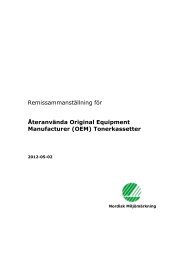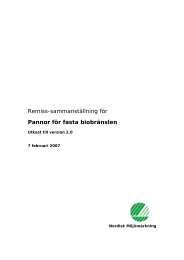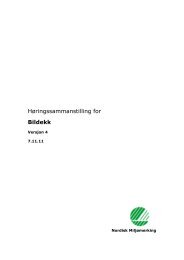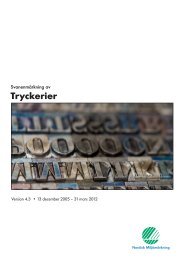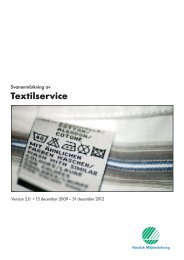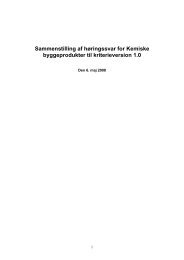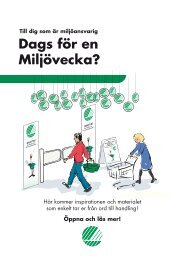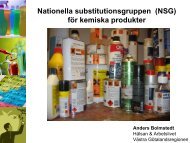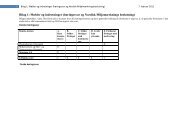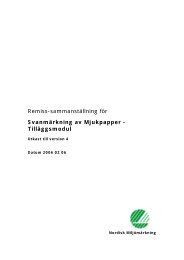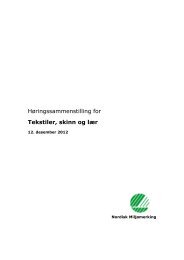Småhus, flerbostadshus och förskolebyggnader - Svanen
Småhus, flerbostadshus och förskolebyggnader - Svanen
Småhus, flerbostadshus och förskolebyggnader - Svanen
Create successful ePaper yourself
Turn your PDF publications into a flip-book with our unique Google optimized e-Paper software.
Nordisk Miljømerking<br />
Hus, leiligheter og barnehager 089/versjon 2<br />
Høringssammenstilling, oppdatert 10. august 2010<br />
available on the market, which will significantly improve the overall energy and material<br />
balance of the building (see examples above).<br />
BING calls on the Nordic Ecolabel to achieve consistency between the Background<br />
report and the draft ecolabelling text, to remove the ban of halogenated flame retardants<br />
or limit it to brominated flame retardants or, at least, allow the use of those flame<br />
retardants for which the EU risk assessment has concluded that the substance is not<br />
hazardous and hence no classification and labelling is required.<br />
European Council for Plasticisers and Intermediates (ECPI)<br />
Substances should not be grouped (Prohibited Substances, 017 and 022)<br />
Grouping substances by family is entirely inappropriate as many “families” of chemicals<br />
consist of substances which are both structurally and toxicologically quite different.<br />
Phthalates are one such example. The phthalate “family” consists of numerous<br />
substances, each of which has a different chemical structure which gives it its own<br />
characteristics. Whereas phthalates such as DEHP, DBP and BBP are classified as<br />
category 2 reproductive toxicants, there are those such as DINP and DIDP which have no<br />
hazardous properties and which are therefore quite different.<br />
There are no grounds for prohibiting the use of DINP and DIDP<br />
There are no grounds on which the use of Di-isononyl phthalate (DINP) and Diisodecyl<br />
phthalate (DIDP) should be prohibited from use:<br />
• DINP and DIDP have been the subject of a comprehensive EU risk assessments 1<br />
conducted over a 10 year period. The conclusion of the risk assessment reports is<br />
that no risk reduction is required for any current application of DINP or DIDP.<br />
• DINP and DIDP are not classified or labelled under the EU Dangerous Substances<br />
Directive for any hazardous properties. This has been confirmed by expert review<br />
within the EU regulatory process.<br />
• DINP and DIDP are not PBT or vPvB substances. This is also addressed in the<br />
EU Risk Assessments. Published laboratory and field studies have shown that<br />
DINP and DIDP do not bioaccumulate or biomagnify in the food chain. These<br />
studies are based on advanced analytical techniques which can detect trace levels<br />
of the substances in the environment. Detection capability does not equate to risk<br />
to health or the environment.<br />
• DINP and DIDP are not endocrine disrupters as defined by Weybridge 2 , REACH<br />
and other international definitions. DINP has been subject to a comprehensive 2generation<br />
rodent study - the test recognized by OECD to be one of the most<br />
rigorous tests for effects on the reproductive system mediated via the endocrine<br />
system. More than 10 years ago, assessments of the oestrogenic potential of DINP<br />
using yeast cells and human cell models showed a weak response for DINP. The<br />
report authors warned that the relevance of these results to a whole animal was<br />
unclear and that further tests were recommended 3 . Additional tests were carried<br />
out in cells and in suitable whole-animal models and the original findings were<br />
not confirmed 4 . Additionally, proposed effects of DINP on testosterone and other<br />
proposed anti-androgenic effects from non-guideline research studies 5 , 6 ,are of<br />
unclear significance and have not been confirmed in the robust OECD Guideline<br />
two-generation rodent study 7 .<br />
88 (165)



